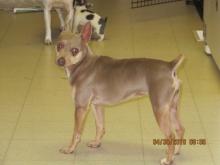Learn Canine Color Genetics
Canine Coat Color Basics
Colors: Black, Yellow, and Red
Canines produce two types of pigment: eumelanin, which is black pigment; and phaeomelanin which is red/yellow pigment. It is the combination of these pigments, along with dilutions, modifiers, and white patterns, that make up the entire spectrum of dog coat colors.
In dogs and wolves there are four known alleles of the extension locus: EM, EG, E, and e. In the absence of dilutions or white patterns, a dog that is ee will be red or yellow. Its skin and eyes will still be dark, but the coat will only contain red or yellow pigment; thereby producing a red or yellow dog. In an ee dog, many other genes are masked. They are there, and will still be passed on to offspring, but they will not express. Dilutions and white patterns will still affect an ee dog.
- Read more about Canine Coat Color Basics
- 10 comments
- Log in or register to post comments
Adding to the basics: Dilutions and Modifiers in Dogs
There are many different dilution and modifier genes that can affect coat color (and sometimes skin pigmentation) in dogs. These include Brown (liver), Dilution (the D locus), Dilution of Red (Pheomelanin), Urajiro, Graying, and Merle.
How the Dog Got It's Spots...
During fetal development cells called melanocytes migrate out from the spinal cord to other areas of the body. These melanocytes produce the pigment that “colors†the dogs coat and skin. Areas where the melanocytes do not reach during fetal development remain without pigment causing areas of white hair and pink skin. The areas most commonly white in dogs are the last areas that are reached by the melanocytes: the chest, tip of the tail, and the toes. The current theory on white pattern development is that environmental factors in the womb (and perhaps white booster or suppressor genes) can affect melanocytes migration resulting in small white spots in these areas without an actual white pattern mutation. When mutations occur in the genes that control melanocyte migration, large areas of white can result. Recent studies have shown that at least one white pattern is the result of a mutation in the gene microphthalmia-associated transcription factor (MITF). However, this mutation does not account for all the white patterns found in canines and in some dogs the mutation does not follow the expected pattern indicating additional genes at work. (Schmutz et al. 2009)
- Read more about How the Dog Got It's Spots...
- 1 comment
- Log in or register to post comments


